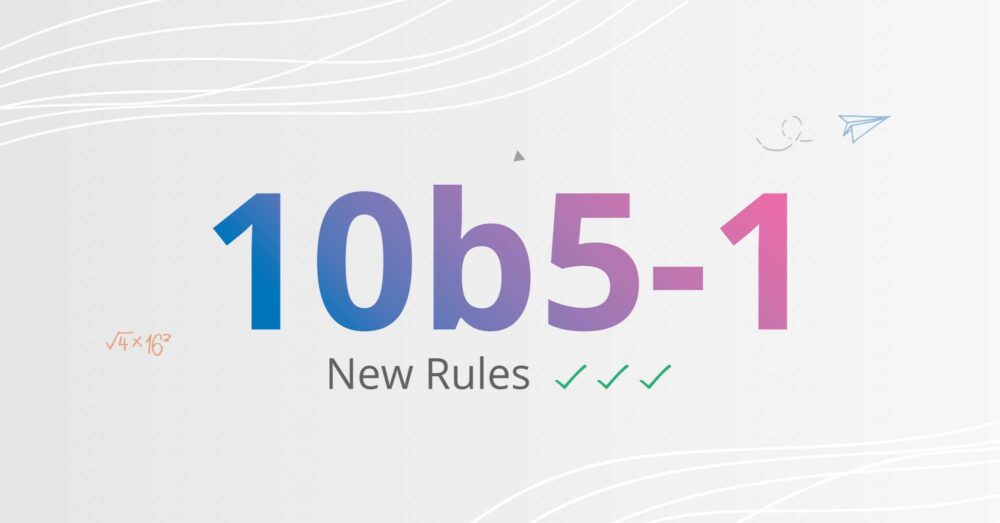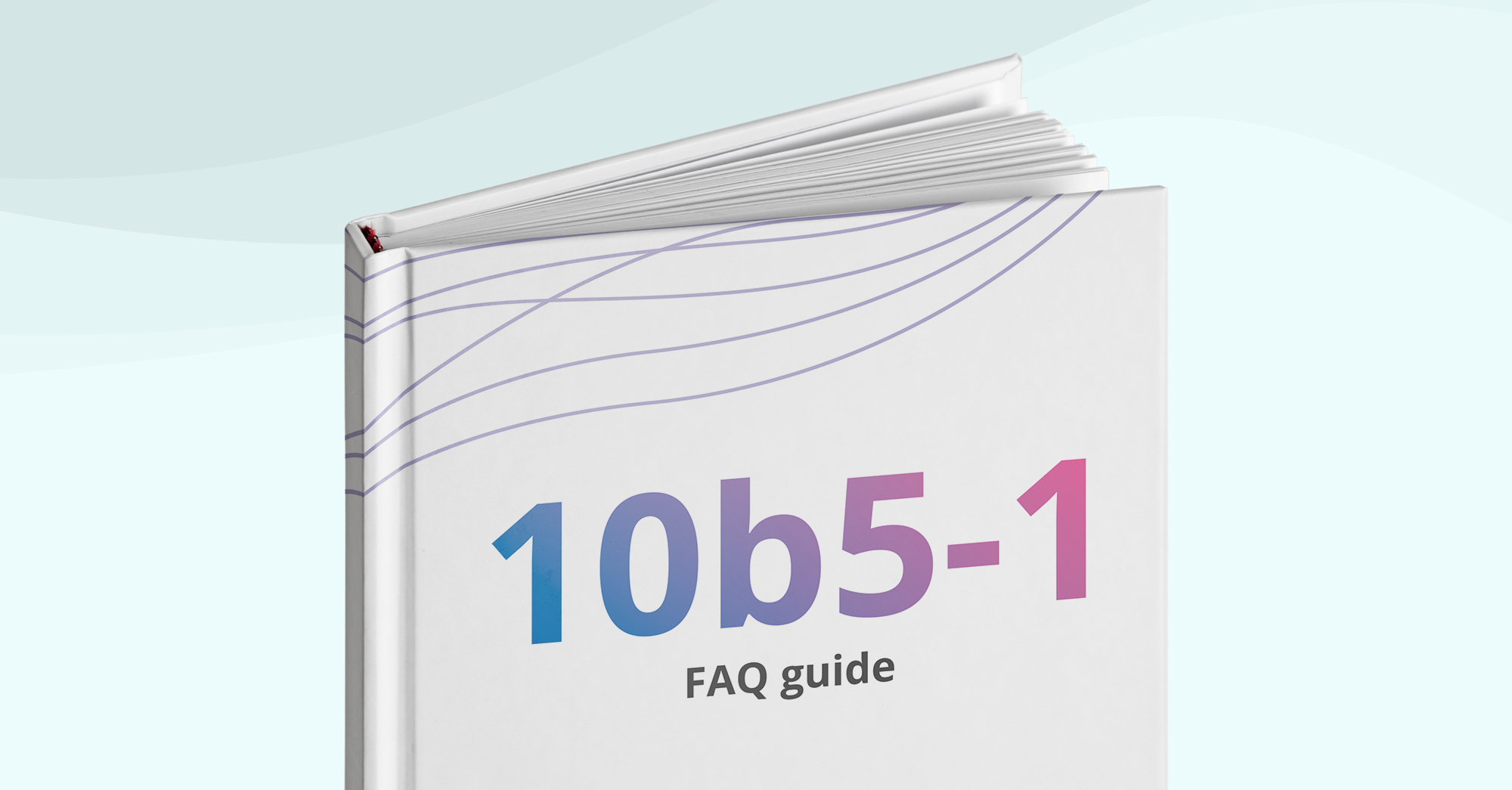SEC updates 10b5-1 trading plan conditions to remove leeway for insider trading rules abuses
The Securities and Exchange Commission (SEC) recently implemented a series of amendments to tighten up legislation designed to allow public company insiders buy and/or sell stock in their business without falling foul of insider trading laws.
Rule 10b5-1 was first introduced in 2000, under the provisions of the Securities Exchange Act 1934, but concerns have been expressed over time about the possibility of individuals using their inside knowledge to engage in opportunistic transactions while also seeking to avail of the protections offered under the legislation.
Arising from these concerns, the SEC announced at the end of last year that 10b5-1 rule changes were to be introduced in early 2023, with a view towards removing whatever ambiguities may have existed in the original restrictions, thus preventing scenarios whereby individuals could in theory seek to use their inside knowledge to facilitate advantageous trading under the cover of a Rule 10b5-1 trading plan.
The rule changes largely revolve around increased declaration obligations and the introduction of cooling off periods. More on the specifics later, but first, let’s remind ourselves of what Rule 10b5-1 is and the purpose it is meant to serve.
What is a 10b5-1 plan?
The purpose of Rule 10b5-1 is to provide an affirmative defense for employees, officers, and directors of public companies against possible accusations of insider trading on the basis of material non-public information (MNPI). So, trading plans that meet the conditions set out in the legislation allow individuals to fall back on that defense in the event of questions being raised about the legality of transactions.
How does an 10b5-1 plan work?
It is not unusual for large shareholders in a public company to want to buy or sell some of their shares from time to time. Rule 10b5-1 plans allow them to do so with an element of protection, in that if the conditions are adhered to, then most likely no insider trading laws will have been violated in the relevant transactions.
To be compliant with Rule 10b5-1, insiders need to put a plan in writing with, for example, details on how many shares are to be bought or sold, the price to be paid (this may be a set price, a limit order price or the market price at the time in question), when these transactions are to take place, and details on whatever formula or metrics are used in making those determinations. Crucially, the insider must also pledge at the time of making the plan that they are not in possession of any MNPI.
So, a hypothetical scenario might see an insider make a contract with a broker to the effect that the latter sell on their behalf X number of shares on the first Monday of every month for a defined period of time. The insider would also make a good faith pledge at the outset that they are not privy to any MNPI that might influence the company share price one way or another. In the absence of any evidence to the contrary prior to the recent changes, the above would have been deemed sufficient for any plan to be deemed Rule 10b5-1-compliant.

What are the new rules for 10b5-1 plans?
As alluded to earlier, the SEC had become aware over time of concerns around possible abuses of Rule 10b5-1, with instances of plans ostensibly compliant with 10b5-1 rules proving lucrative for insiders and thus raising concerns around whether the rules on MNPI were being fully observed.
The SEC indicated in 2021 that they were looking at tightening up 10b5-1 plan conditions and followed through with the announcement in December 2022 that a raft of amendments to the existing rules would come into effect on February 27, 2023 (60 days on from being published in the Federal Register).
The new measures include:
- Mandatory cooling-off periods: For the first time, insiders now have to observe a cooling-off period between the formal adoption of a 10b5-1 trading plan and any subsequent trades linked to that plan. The length of the cooling-off period varies depending upon the position held by an individual – 90 to 120 days for directors and officers and 30 days for others deemed to be insiders. The logic of this measure is that by removing the ability of insiders to trade immediately or very soon after adopting a trading plan, you greatly reduce their ability to benefit from whatever MNPI they may possess.
- Restrictions on overlapping plans: For any individual, the affirmative defense will only be made available for one trading plan at a time. Any subsequent plan someone may wish to enter into will immediately be deemed ineligible for the 10b5-1 protections. The logic of this measure is to discourage the creation of multiple overlapping plans for the purposes of hedging. However, there are some exceptions to this rule, e.g., two separate 10b5-1 plans can operate at the same time if one only authorizes qualified sell-to-cover transactions, and also two eligible plans can exist at the same time as long as trades under one do not commence until the other plan is completed or expires without execution.
- Restrictions on single-trade plans: Insiders are limited to one single-trade plan in any 12-month period. Again, there are exceptions, e.g., qualified sell-to-cover transactions.
- Certifications: Directors and officers are now obliged to provide a written representation stating clearly that they are not aware of any MNPI related to the issuer and also that they are entering into the plan in good faith, i.e., that it can be taken at face value and is not part of a scheme to evade insider trading rules.
- Good faith: The good faith requirements associated with Rule 10b5-1 have been expanded. Whereas prior to the introduction of the amendments, insiders and issuers were required to declare their good faith at the outset of the trading plan, now they are formally required to behave in good faith throughout the life of the plan.
- Disclosures: Issuers, directors, and executive officers all now face increased reporting requirements. Among the updated requirements are that issuers must provide quarterly reports on how directors and officers use trading plans, and directors and officers will have to identify all relevant trades and are also obliged to report any gifts or donations of securities.
- Amendments to Forms 4 and 5: Since April 1, insiders now face amended reporting obligations associated with SEC Form 4, Statement of Changes in Beneficial Ownership, and SEC Form 5, Annual Statement of Changes in Beneficial Ownership of Securities. Individuals submitting these documents are now required to indicate by checkbox that the transaction in question is intended to comply with the terms of Rule 10b5-1 and also to specify the date on which the trading plan was adopted. Also, any securities-related gifts previously reported on Form 5 must now to be reported on Form 4. On the filing timeline, Form 4 must be filed within two business days of a relevant transaction, whereas in the normal run of affairs Form 5 is due no later than 45 days after the end of the company’s fiscal year. So, under the updated regime, gifts must now be reported much sooner than before. This reflects the SEC’s intention to remove any potential ambiguity on gifted securities, i.e., gifted securities can be covered under 10b5-1, but the SEC view is that if a donor knows that a recipient will sell gifted securities shortly after receiving them, then that is a gift in the true sense of the word, and if the recipient is in possession of MNPI, then there could be insider trading implications.
What about existing plans?
Plans entered into prior to the introduction of the new rules will not be affected by these changes. However, if pre-existing plans are modified – e.g., price or timing of a transaction or the amount of shares involved – then the new restrictions will apply. In simple terms, from the SEC perspective, such modifications effectively amount to the termination of the existing plan and the adoption of a new one.
What should companies do now?
In light of these changes, public companies should review their insider trading policies and guidelines, if they have not already done so.
Our team of experienced professionals is also on hand to offer guidance on whatever Rule 10b5-1-related queries you may have. Feel free to contact us today.
This publication contains general information only and J.P. Morgan Workplace Solutions is not, through this article, issuing any advice, be it legal, financial, tax-related, business-related, professional or other. J.P. Morgan Workplace Solutions’ Insights is not a substitute for professional advice and should not be used as such. J.P. Morgan Workplace Solutions does not assume any liability for reliance on the information provided herein.



